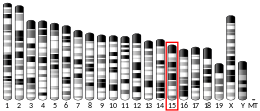DNAH5
Dynein heavy chain 5, axonemal is a protein that in humans is encoded by the DNAH5 gene.[5][6][7]
The DNAH5 gene is a protein-coding gene.1 It provides the instructions for synthesizing a protein that belongs to a microtubule-associated protein complex made of heavy, light and intermediate chains.2 The DNAH5 gene is responsible for making the heavy chain 5, found within the outer dynein arms of cilia.1 It will function as a force generating protein by using ATP, producing the power stroke for cilia.3
During early development, the cilia found on the primitive node will beat in a directional pattern, sending signaling molecules to the left, this process will begin to establish the internal left-right asymmetry.3 Mutations of the DNAH5 gene are linked to primary ciliary dyskinesia, an autosomal recessive disorder.4 This X-linked disorder is characterized by recurrent respiratory infections, infertility, and abnormal organ placement.1 Non-functional DNAH5 proteins have been identified in individuals with primary ciliary dyskinesia and randomized left-right asymmetry.4
References
- GRCh38: Ensembl release 89: ENSG00000039139 - Ensembl, May 2017
- GRCm38: Ensembl release 89: ENSMUSG00000022262 - Ensembl, May 2017
- "Human PubMed Reference:". National Center for Biotechnology Information, U.S. National Library of Medicine.
- "Mouse PubMed Reference:". National Center for Biotechnology Information, U.S. National Library of Medicine.
- Chapelin C, Duriez B, Magnino F, Goossens M, Escudier E, Amselem S (Sep 1997). "Isolation of several human axonemal dynein heavy chain genes: genomic structure of the catalytic site, phylogenetic analysis and chromosomal assignment". FEBS Lett. 412 (2): 325–30. doi:10.1016/S0014-5793(97)00800-4. PMID 9256245.
- Olbrich H, Haffner K, Kispert A, Volkel A, Volz A, Sasmaz G, Reinhardt R, Hennig S, Lehrach H, Konietzko N, Zariwala M, Noone PG, Knowles M, Mitchison HM, Meeks M, Chung EM, Hildebrandt F, Sudbrak R, Omran H (Jan 2002). "Mutations in DNAH5 cause primary ciliary dyskinesia and randomization of left-right asymmetry". Nat Genet. 30 (2): 143–4. doi:10.1038/ng817. PMID 11788826.
- "Entrez Gene: DNAH5 dynein, axonemal, heavy chain 5".
External links
Further reading
- Jouannet P, Escaller D, Serres C, David G (1983). "Motility of human sperm without outer dynein arms". J. Submicrosc. Cytol. 15 (1): 67–71. PMID 6221120.
- Vaughan KT, Mikami A, Paschal BM, et al. (1997). "Multiple mouse chromosomal loci for dynein-based motility". Genomics. 36 (1): 29–38. doi:10.1006/geno.1996.0422. PMID 8812413.
- Neesen J, Koehler MR, Kirschner R, et al. (1997). "Identification of dynein heavy chain genes expressed in human and mouse testis: chromosomal localization of an axonemal dynein gene". Gene. 200 (1–2): 193–202. doi:10.1016/S0378-1119(97)00417-4. PMID 9373155.
- Nagase T, Kikuno R, Nakayama M, et al. (2001). "Prediction of the coding sequences of unidentified human genes. XVIII. The complete sequences of 100 new cDNA clones from brain which code for large proteins in vitro". DNA Res. 7 (4): 273–81. doi:10.1093/dnares/7.4.271. PMID 10997877.
- Omran H, Häffner K, Völkel A, et al. (2000). "Homozygosity mapping of a gene locus for primary ciliary dyskinesia on chromosome 5p and identification of the heavy dynein chain DNAH5 as a candidate gene". Am. J. Respir. Cell Mol. Biol. 23 (5): 696–702. doi:10.1165/ajrcmb.23.5.4257. PMID 11062149.
- Ota T, Suzuki Y, Nishikawa T, et al. (2004). "Complete sequencing and characterization of 21,243 full-length human cDNAs". Nat. Genet. 36 (1): 40–5. doi:10.1038/ng1285. PMID 14702039.
- Horváth J, Fliegauf M, Olbrich H, et al. (2005). "Identification and analysis of axonemal dynein light chain 1 in primary ciliary dyskinesia patients". Am. J. Respir. Cell Mol. Biol. 33 (1): 41–7. doi:10.1165/rcmb.2004-0335OC. PMID 15845866.
- Olbrich H, Horváth J, Fekete A, et al. (2006). "Axonemal localization of the dynein component DNAH5 is not altered in secondary ciliary dyskinesia". Pediatr. Res. 59 (3): 418–22. doi:10.1203/01.pdr.0000200809.21364.e2. PMID 16492982.
- Hornef N, Olbrich H, Horvath J, et al. (2006). "DNAH5 mutations are a common cause of primary ciliary dyskinesia with outer dynein arm defects". Am. J. Respir. Crit. Care Med. 174 (2): 120–6. doi:10.1164/rccm.200601-084OC. PMC 2662904. PMID 16627867.
- DNAH5 gene - Genetics Home Reference - NIH. U.S. National Library of Medicine. https://ghr.nlm.nih.gov/gene/DNAH5. Accessed April 15, 2019.
- Djakow J, Svobodová T, Hrach K, Uhlík J, Cinek O, Pohunek P. Effectiveness of sequencing selected exons of DNAH5 and DNAI1 in diagnosis of primary ciliary dyskinesia. Pediatric Pulmonology. 2012;47(9):864-875. doi:10.1002/ppul.22520.
- Andjelkovic M, Minic P, Vreca M, et al. Genomic profiling supports the diagnosis of primary ciliary dyskinesia and reveals novel candidate genes and genetic variants. Plos One. 2018;13(10). doi:10.1371/journal.pone.0205422.
- Xu X, Gong P, Wen J. Clinical and genetic analysis of a family with Kartagener syndrome caused by novel DNAH5 mutations. Journal of Assisted Reproduction and Genetics. 2016;34(2):275-281. doi:10.1007/s10815-016-0849-3.



